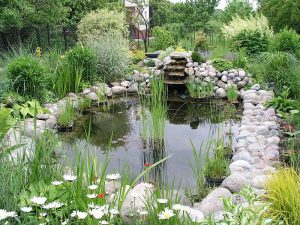
Father Natures carries all your ponding needs.
Long, balmy summer days are great for enjoying your pond, but the heat can take its toll on your pond and fish. August is prime algae time, but by the time you see that massive green outbreak, your pond is already under duress. Another sign of trouble is seeing your fish gasping for air near the surface or near a waterfall.
If you notice either of those things, don’t panic. Take some steps to re-balance your pond and get it healthy again. Better yet, take preventative measures before trouble hits so you can continue to enjoy your pond and fish for the rest of the season.
Here are a few key things you can do to keep your pond and its inhabitants happy and healthy during the dog days of summer.
Watch The Temperature
If your water temperature rises above 75 degrees Fahrenheit, things can start to go very badly, very quickly. Warmer water holds less oxygen, which is why you may see fish gasping for air.
To make matters worse, fish are more active in warmer temperatures, which means they need even moreoxygen at precisely the time when less is available. That can result is stressed fish, and stressed fish are more susceptible to disease.
To end the vicious cycle (or better yet, to prevent it in the first place), keep your pond in a healthy temperature range between 68 and 74 degrees. Not sure what the water temperature is? There’s a very simple solution – a thermometer. If you don’t have one, invest in one immediately. They’re inexpensive and invaluable.
But knowing the temperature is only part of the battle. How can you keep it safely out of the danger zone?
Start by ensuring that your pond has proper shade. As a rule of thumb, plants should cover from one-third to one-half of your pond’s surface area. Waterlilies and other floaters like water lettuce not only look great but they give your pond the much-needed shade that will help regulate water temperature. As an added benefit, floaters will absorb excess nutrients in the water that might otherwise result in an algae bloom.
You can also add an arbor, pergola or other natural covering to create a more shaded environment.
If the temperature is already too high, you may need to add cooler water to bring it down. Be exceptionally careful when doing this, though. A dose of cold water directly from a garden hose can shock fish and harm or even kill them. Also, tap water tends to be higher in the minerals and nutrients that algae needs to bloom, and an outbreak of the green stuff is the last thing you want. A better way to add water is from a rainwater harvest, or put tap water into buckets so the temperature warms a bit and then add it a little at a time.
Feed Fish Properly
Fish are more active in the summer, which means they eat more. And eating more means they produce more waste. Excess food plus excess waste creates exactly the right environment that algae loves, so it’s important to keep both under control during hot summer months.
Start by feeding fish a formula designed specifically for warm months. These tend to be higher in protein, which will provide fish with the energy they need commensurate to their activity. Choose a high-quality food because low-quality food tends to be harder for fish to digest, which means it will pass in and out quickly, turning to waste instead of being used properly for energy. And remember, the more waste, the more likely you are to have excess nutrients that can result in algae.
And be sure not to overfeed. You can use a programmable automatic food dosing system to help control portions, or if you’re doing it manually, feed fish between one and three times daily, no more than they can eat within five minutes. If you notice leftover food floating around (or sinking) in your pond, your best bet is to scoop it out with a net then reduce the amount at the next feeding.
Feed during the morning or early evening since fish prefer that light to the bright sun of midday. For a special treat, you can even feed them bits of lettuce or chopped up chunks of fruits and vegetables.
Circulate, Aerate And Filter
Using effective filtration and aeration methods will help keep temperature regulated, increase oxygen levels and keep water clean – all of which contribute to the health of your fish.
Waterfalls and bubblers are not only beautiful and pleasing additions to your pond, but they serve another important function: circulating water to help keep it aerated. Aeration allows for the exchange of harmful gases that build up as a result of decomposition while adding essential oxygen. Alternatively, you can add an aeration pump if necessary.
Run your filter all summer, and be mindful that plants and algae can accumulate and clog filters, so check periodically to ensure that they’re clean and functioning. For most benefit, use a mechanical filter and a biological filter together. A biological filter will provide the necessary beneficial bacteria that are pivotal in breaking down excess nutrients and controlling algae.
Keep It Clean
Even though a balanced pond is self-cleaning, it can still become cluttered with lawn clippings, fallen leaves and other natural debris. If that happens, the debris will begin to decompose and add nutrients to the water, and by now you know how easily that can become a food source for a thriving batch of algae.
Skim floating debris off the top of the water when you can, and be sure filters are kept clear of blockage and functioning properly. Remove pond weeds that may be floating in dead clusters on the surface, and check your marginal beds for traditional weeds.
Dead and dying pond plants can have the same effect. Remove yellowing leaves and fading flowers before they fall into the pond to decompose. Likewise, remove any floating plants that haven’t fared as well.
If you’re struggling to keep your pond clean and healthy even with effort, consider upgrading your filter to be able to handle a higher capacity. Filter ratings are based on a best-case scenario, and the conditions of your pond can affect how well it works.
If algae becomes a problem, first be sure that you’ve taken measures to discourage further growth as we’ve mentioned here – remove debris, check or improve your filtration system, run or add a water feature like a waterfall or bubbler, switch to a high-quality fish food and be sure your pond has enough shade.
If you see the green stuff growing on rocks, you can give it a blast of water from a hose to remove it. For a chemical-free solution, try an electronic water clarifier like Aquascape’s Iongen.
A naturally balanced pond is easy to maintain, but a little TLC during hot summer months will keep it healthy and thriving. If you have questions about your pond, or need help to deal with algae, sick fish or another challenge, let us know. Our pond shop experts can advise you on products to use, nurse fish back to health or visit your home to see how we can improve your ecosystem.

